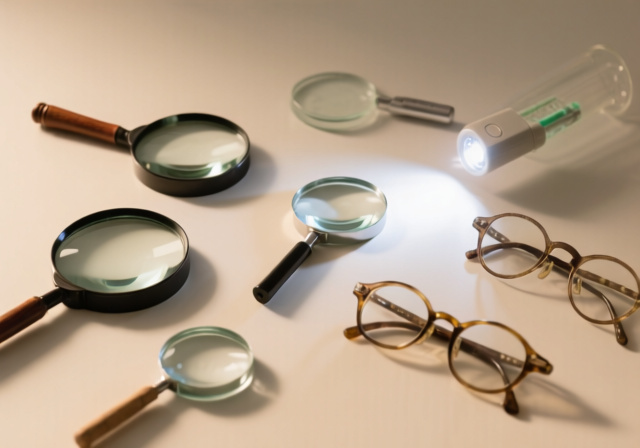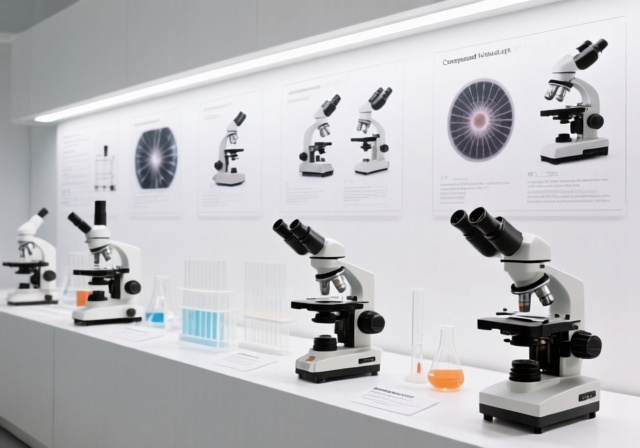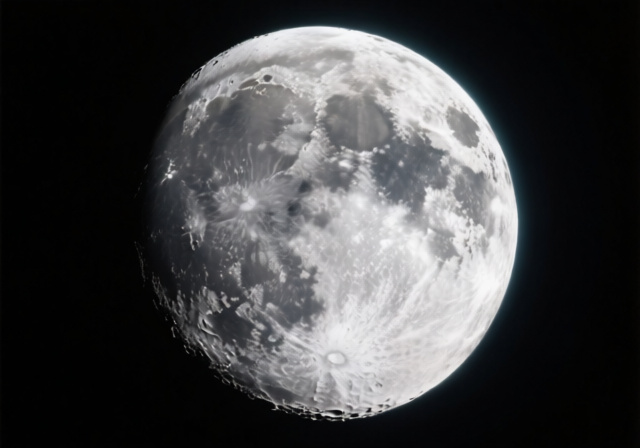



Magnifying glasses have been essential tools for humanity thousands of years, yet most people only know them as simple reading aids. These remarkable optical devices have enabled scientific discoveries, revolutionized industries, and continue to evolve with modern technology.
Magnifying glasses are convex lenses that bend light to create enlarged virtual images, making small objects appear larger and closer than they actually are. From ancient crystal lenses to modern LED illuminated models, these simple yet powerful tools have shaped how we see the microscopic world around us.
What you’re about to discover might surprise you. These 15 fascinating facts reveal the hidden history, surprising applications, and scientific principles behind one of humanity’s oldest optical instruments.
The earliest magnifying devices weren’t glass at all. Ancient Egyptians used polished crystal rocks as early as 2000 BCE to inspect small details and even start fires by concentrating sunlight. These primitive magnifiers demonstrate humanity’s long-standing desire to see beyond natural vision limits.
By 700 BCE, the Assyrians were developing ground crystal lenses, primarily used as decorative items but occasionally for magnification. These early attempts laid the groundwork for the sophisticated optical devices we use today.
Nero, the infamous Roman Emperor (54-68 AD), famously watched gladiator games through a polished emerald. While not a true magnifying glass, this gemstone acted as a corrective lens, reducing glare and potentially providing slight magnification. This historical account represents one of the earliest documented uses of optical aids for vision enhancement.
English philosopher Roger Bacon revolutionized optics in the 13th century. Around 1268, he documented the principles of magnification and proposed using lenses for vision correction. Bacon’s scientific writings described how convex lenses could “make small letters appear larger” and help elderly readers with failing eyesight.
Bacon’s systematic study of magnification principles earned him recognition as one of the pioneers of optical science, bridging ancient knowledge with modern understanding of light refraction.
Magnifying glasses work through a principle called refraction. When light passes through the convex lens, it bends inward, converging at a point called the focal point. This convergence creates a virtual image that appears larger and closer than the actual object.
The magnification power depends on the lens’s focal length – shorter focal lengths produce stronger magnification. This simple physics principle enables magnifications ranging from 2x for reading aids to over 30x for specialized scientific applications.
Before modern glasses, medieval scholars used “reading stones” – hemispherical glass objects placed directly on text. These early magnifiers, popular in the 11th-13th centuries, allowed monks and scholars with presbyopia to continue their work despite age-related vision changes.
These reading stones were essentially large, crude magnifying glasses that demonstrated the practical value of magnification long before the science was fully understood.
The simple magnifying glass directly led to the invention of the microscope and telescope. Antonie van Leeuwenhoek’s powerful magnifiers in the 1670s revealed the microscopic world of bacteria and cells, fundamentally changing medicine and biology.
Galileo Galilei applied similar principles to create telescopes that revolutionized astronomy. Without the humble magnifying glass, modern science might have developed very differently.
Magnifying glasses can concentrate sunlight to reach temperatures exceeding 400°F (204°C), enough to ignite most dry materials. This property has been used for centuries as a reliable fire-starting method, especially in survival situations.
Modern survival kits often include magnifying glasses specifically for this purpose. The physics is simple: the lens focuses sunlight into a tiny point, concentrating solar energy to create intense heat.
Not all magnifying glasses are created equal. Double-convex lenses curve outward on both sides and provide the strongest magnification. Plano-convex lenses are flat on one side and curved on the other, offering less distortion for extended viewing.
Specialized Fresnel lenses use concentric rings to achieve powerful magnification in a thin, lightweight design. These innovations demonstrate how magnification technology has evolved beyond simple glass discs.
Art historians and forensic experts rely heavily on magnifying glasses to examine details invisible to the naked eye. They can analyze brush strokes, detect forgeries, and examine evidence with precision that would be impossible otherwise.
Stamp collectors, coin enthusiasts, and jewelry appraisers depend on quality magnifiers to spot tiny details that determine value and authenticity. These specialized applications show how magnification expertise extends far beyond simple reading assistance.
Surgeons and dentists use specialized magnifying glasses called loupes to perform delicate procedures with enhanced precision. These medical-grade magnifiers can be mounted on glasses or headbands, allowing hands-free operation during critical work.
Dermatologists use dermatoscopes – specialized magnifiers with built-in lighting – to examine skin lesions for signs of cancer. This medical application literally saves lives through enhanced visualization.
The magnifying glass principle exists throughout nature. The human eye itself contains a convex lens that focuses light onto the retina. Many insects have compound eyes that function similarly to multiple tiny magnifiers working together.
Even some deep-sea creatures have developed natural magnification systems to gather maximum light in dark ocean environments. This biological parallel shows how fundamental the magnification principle is to vision.
Modern magnifying glasses often incorporate LED lighting, solving one of the biggest challenges in magnification: adequate illumination. Lighted magnifiers eliminate shadows and provide consistent brightness, making them especially useful for people with vision impairments.
This innovation combines two essential elements – magnification and illumination – into one convenient tool, dramatically improving usability in various lighting conditions.
Digital magnifiers represent the latest evolution in magnification technology. These devices use cameras and screens to provide variable magnification, image enhancement, and even text-to-speech capabilities for users with severe vision impairments.
Some advanced digital magnifiers can connect to computers and smartphones, integrating seamlessly with modern technology. This fusion of optical and digital technology opens new possibilities for accessibility and functionality.
Astronauts use specialized magnifying glasses in space for equipment inspection and repairs. These space-grade magnifiers are designed to work in zero gravity and extreme conditions, demonstrating how fundamental magnification remains even in high-tech environments.
Space telescopes like Hubble use massive magnification systems that operate on the same basic principles as handheld magnifiers – just on an astronomical scale.
Researchers are developing smart magnifying glasses with augmented reality capabilities. These future devices could provide real-time information about magnified objects, translation capabilities, and even AI-assisted identification of specimens.
Quantum dots and other advanced materials promise to create even more powerful and compact magnification systems. The future of magnification technology continues to evolve while building on ancient principles.
The story of magnification begins in ancient civilizations where curious minds discovered that certain materials could make objects appear larger. The earliest known magnifying devices were simple polished crystals used by ancient Egyptians around 2000 BCE. These natural lenses, often made from quartz or beryl, were rudimentary but effective for basic magnification needs.
By 1000 BCE, ancient Greeks were experimenting with water-filled glass spheres that created magnification effects. These early attempts at creating optical devices laid the foundation for understanding how light behaves when passing through curved surfaces. The Greeks documented their observations, noting how these spheres could make small objects appear larger and closer.
The Roman Empire contributed significantly to early optics. Seneca the Younger (4 BC – 65 AD) described how a glass globe filled with water could be used to magnify letters, making them easier to read. This practical application demonstrates that ancient civilizations recognized magnification’s value for everyday tasks.
During the Islamic Golden Age (8th-14th centuries), scholars like Ibn al-Haytham (Alhazen) made groundbreaking discoveries about optics. His “Book of Optics” explained how vision works and laid the scientific principles that would later enable the creation of proper magnifying glasses. Alhazen’s understanding of light refraction was centuries ahead of European science.
The first true magnifying glasses as we know them today appeared in medieval Europe around the 13th century. Craftsmen in Venice, famous for their glassmaking skills, began producing small convex lenses mounted in frames. These early magnifiers were luxury items, affordable only to wealthy scholars and nobles who needed them for reading and detailed work.
The invention of the printing press in 1440 dramatically increased demand for magnifying glasses. As books became more common, so did age-related vision problems among readers. Magnifiers transitioned from luxury items to essential tools for anyone working with printed materials.
A magnifying glass is essentially a convex lens – a piece of glass or plastic curved outward on both sides. When light passes through this curved surface, it bends in a process called refraction. This bending causes the light rays to converge, creating a virtual image that appears larger and closer than the actual object.
The key to magnification lies in the lens’s focal length – the distance from the lens where parallel light rays converge. Shorter focal lengths create stronger magnification but reduce the field of view. This relationship explains why high-power magnifiers show smaller areas at greater enlargement.
When you hold a magnifying glass at the optimal distance from an object, the lens creates an enlarged virtual image. Your eye perceives this image as if the object were closer and larger. This optical illusion happens because the lens changes the angle at which light reaches your eye, making your brain interpret the object as bigger than it actually is.
Magnification power is measured in diopters or as a multiple (2x, 5x, etc.). A 2-diopter lens provides approximately 2x magnification, while a 10-diopter lens offers about 3x magnification. The relationship between diopters and magnification isn’t linear, which is why higher powers don’t always mean proportionally larger images.
The quality of a magnifying glass depends on several factors: lens material, curvature precision, and coating quality. High-quality glass lenses provide clearer images than plastic, while anti-reflective coatings reduce glare and improve clarity. The precision of the lens curvature affects how evenly the magnification works across the entire viewing area.
Convex Lens: A lens that curves outward on both sides, causing light rays to converge and create magnified virtual images.
Modern magnifying glasses often incorporate multiple lens elements to correct for optical distortions. These compound lenses can provide clearer images with less color fringing and edge distortion, especially at higher magnifications.
The world of magnification extends far beyond simple handheld lenses. Different types of magnifying glasses serve specific purposes, each optimized for particular tasks and user needs.
Handheld magnifiers are the most common type, featuring a lens mounted in a handle for portability and convenience. These range from basic 2x readers to powerful 10x inspection lenses. The best handheld magnifiers combine comfortable ergonomics with quality optics for extended use without fatigue.
Stand magnifiers eliminate hand fatigue by resting directly on reading material. These are ideal for extended reading sessions and provide consistent magnification without requiring steady hands. Many include built-in LED lights for optimal illumination.
Headband magnifiers offer hands-free operation essential for crafts, electronics work, and other detailed tasks. These wearable magnifiers often feature multiple lenses that can be flipped down individually, providing variable magnification from 1.5x to 10x or more.
Loupe magnifiers are small, high-power magnifiers used by jewelers, watchmakers, and collectors. These precision instruments provide magnification from 10x to 30x in a compact form factor, often worn like glasses or held close to the eye.
Fresnel magnifiers use a unique design with concentric ridges to achieve powerful magnification in a thin, lightweight form. Originally developed for lighthouse lenses, modern Fresnel magnifiers are popular for reading large areas like books or newspapers.
Digital magnifiers represent the latest evolution, using cameras and digital displays to provide variable magnification, image enhancement, and additional features like contrast adjustment and text-to-speech capabilities. These are especially valuable for people with low vision.
| Type | Typical Magnification | Best Uses | Pros | Cons |
|---|---|---|---|---|
| Handheld | 2x-10x | General reading, inspection | Portable, versatile | Requires steady hand |
| Stand | 2x-5x | Extended reading | Hands-free, steady | Less portable |
| Headband | 1.5x-10x | Crafts, detailed work | Hands-free, variable power | Can be uncomfortable |
| Loupe | 10x-30x | Jewelry, watch repair | High power, precise | Small field of view |
| Fresnel | 2x-3x | Large area reading | Lightweight, large area | Lower image quality |
Magnifying glasses extend far beyond helping people read small print. These versatile tools find applications in numerous fields, from scientific research to everyday tasks.
The 21st century has brought remarkable innovations to magnification technology. LED integration has revolutionized traditional magnifying glasses by solving the perennial problem of adequate illumination. Modern lighted magnifiers combine bright, energy-efficient LEDs with quality optics, creating superior viewing experiences in any lighting condition.
Digital magnification represents the most significant leap forward. These devices capture images through high-resolution cameras and display them on screens, offering advantages traditional optics cannot match. Variable magnification, image enhancement, contrast adjustment, and even artificial intelligence-powered features make digital magnifiers invaluable for people with low vision.
Smart magnifying glasses with augmented reality capabilities are emerging from research labs. These devices can identify objects, provide real-time information about magnified items, and even translate text instantly. The integration of magnification with connected technology opens possibilities that were science fiction just decades ago.
Materials science has also advanced magnification technology. New optical polymers provide excellent clarity while being lighter and more durable than traditional glass. Anti-reflective coatings, scratch-resistant surfaces, and hydrophobic treatments make modern magnifiers more practical for everyday use.
The future of magnification includes flexible lenses, holographic magnification, and quantum dot technology that could provide unprecedented clarity and power. These developments continue to build on principles discovered thousands of years ago, proving that the magnifying glass remains as relevant today as it was in ancient times.
While no single person invented the magnifying glass, English philosopher Roger Bacon documented its principles in the 13th century. However, magnification devices existed in various forms for thousands of years before Bacon, from ancient Egyptian crystal lenses to medieval reading stones.
Handheld magnifying glasses typically range from 2x to 10x magnification. Specialized loupes can reach 30x or more. Beyond this range, the field of view becomes extremely small and microscopes become more practical. The theoretical maximum depends on lens quality and design, but practical handheld magnifiers rarely exceed 30x.
No, magnifying glasses cannot damage your eyes when used properly. They simply bend light to create enlarged images. However, using magnifiers with strong sunlight can cause eye damage if you look directly at the sun through the lens. Always follow safety guidelines and never use magnifiers to look directly at bright light sources.
A magnifying glass creates a virtual image that appears larger but cannot be projected onto a surface. A microscope creates a real image that can be projected and provides much higher magnification through multiple lens elements. Microscopes typically offer 40x to 1000x magnification, while magnifying glasses usually max out around 30x.
Consider your intended use: 2x-3x for general reading, 4x-6x for detailed work like crafts or hobbies, and 8x-10x for specialized tasks like electronics repair or coin collecting. Higher magnification means smaller field of view, so balance power with your needs. Test different magnifications if possible to find what works best for your eyes and tasks.
From ancient crystals to modern digital devices, magnifying glasses continue to evolve while serving the same fundamental purpose: helping humanity see what’s too small for the naked eye. Whether you’re reading fine print, examining nature’s details, or pursuing specialized hobbies, understanding these magnifying glasses facts reveals the rich history and promising future of this essential optical tool.







